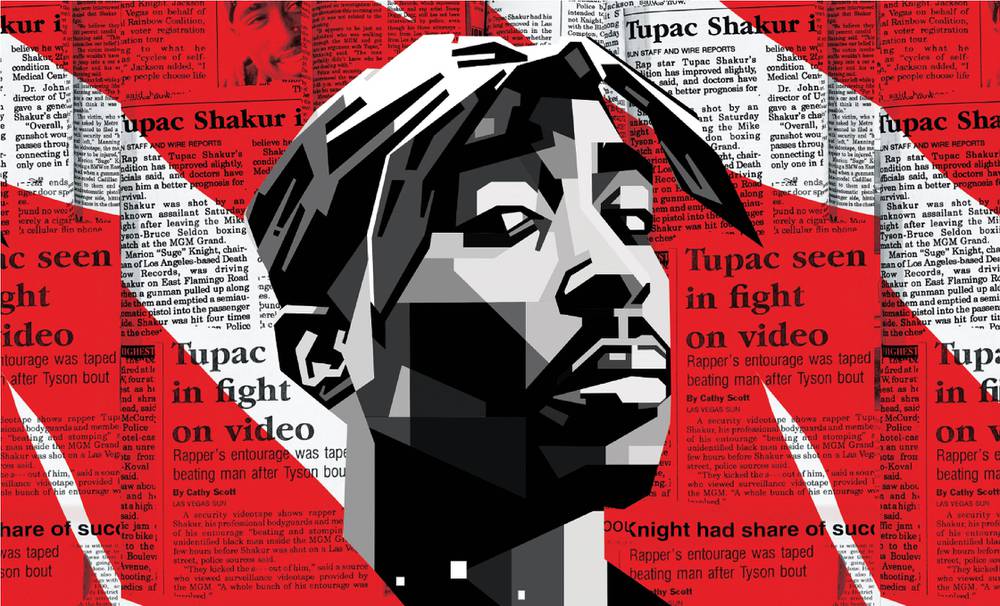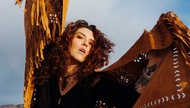At every milestone, the world pauses to consider the life, death and legacy of Tupac Shakur. This month marks the 25-year anniversary of the murder of the legendary rapper, actor, poet and cultural critic, who was just 25 at the time of his death. In a way, this anniversary marks a solemn sort of symmetry: Shakur has now been dead as long as he was alive—yet his star shines as brightly as ever.
It helps that Shakur was a prolific and tireless worker. Perhaps aware that his time on Earth was short, he produced enough material to fuel many posthumous albums. Cut down in the prime of his career, his life will forever be an open question of what else might have been. The fact that his murder remains unsolved gives a sense of unfinished business to his story. But at the bottom of it all was an all-too-human man who bared his soul and made the world a richer place for it.
“As much as he was viewed as a troublemaker, he was very insightful, very thought-provoking,” says Las Vegas-based journalist Andreas Hale. “He would speak up about issues in the community. He turned thug life into something that was meaningful and inspiring to young Black men and women and, eventually, to the rest of the world. When he passed, it was felt almost along the same lines as Martin Luther King and Malcolm X: gone too soon, gone for a reason, because he had something to say. His words had impacted the world in such a way.”
Though Shakur never lived in Las Vegas, he remains intimately connected with our city, and not just because he died here. Locals identified with the West Coast rapper, thinking of Las Vegas as a sister city to LA. “It just meant a lot to us here,” says Soldadera Sanchez, a local activist with Organize the State Out, who grew up in Las Vegas. “We knew that he would come back and forth, and that he co-owned Club 662. So you could catch a glimpse of him here and there. He was just like a local celeb for us as well. That’s why it’s always been so important to us to continue to keep his legacy alive.”
On Shakur’s June 16 birthday, Sanchez and her comrades honored Shakur at the intersection of Flamingo Road and Koval Lane, the location where he was fatally shot. “A few years back, we proclaimed it and renamed it,” says Tenisha Freedom of Organize the State Out. “So we now call it Tupac Drive.” They gather, put up signage and balloons and “bump his music.” Expect a similar spontaneous gathering on September 13, the night he died.
For his 50th birthday, they threw a larger celebration, with proceeds benefiting the effort to liberate political prisoners, especially Shakur’s step-father, Mutulu Shakur. Sanchez and Freedom, among many others, embrace the Shakurs’ political messages against racism and for liberation.
“Our best way to honor [Shakur’s] legacy is continuing on with that work and with the vision that they have,” Freedom says.
In the pages that follow, the Weekly revisits the final days of Shakur’s life, the mystery of his death and his lasting legacy.
A visual timeline of Tupac Shakur’s shooting and its aftermath
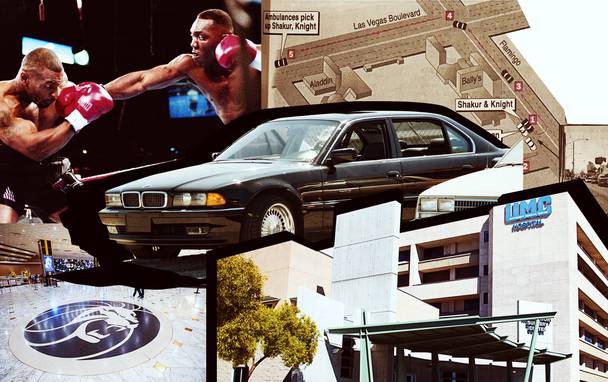
September 7, 1996 Bruce Seldon vs. Mike Tyson boxing match at MGM Grand Garden Arena
Las Vegas-based journalist Andreas Hale says nothing compared to the atmosphere of a Tyson fight night. Though he was only in high school at the time, he was on the scene with his friends to people watch. “It was women and celebrities and hustlers,” Hale says. “You would see everything in the MGM that night. It was also very significant culturally—hip-hop culture was big into everything that Mike Tyson did. It was like our NBA All-Star game. It was like our big hip-hop type of Woodstock.”
Shakur attended the fight, and video footage shows both Shakur and Suge Knight hugging Tyson as the fighter heads backstage. Tyson would later tell Vlad TV that he felt guilty pressuring him to come to the fight. “I was going to go out with him that night,” Tyson says. “I promised to go to 662 with him that night, but I’d just had a little baby, and her mother provoked me to stay home. Somebody called me that night and told me what happened.”
(About 8:50 p.m.) Shakur and his entourage assault Orlando Anderson in the MGM Grand lobby area
The altercation is caught on casino security footage. “We got there that night, when Tupac was being escorted out—I didn’t know who it was,” Hale says. “We saw this big commotion in the lobby. Somebody said, ‘I think that was Tupac.’ And we just kind of carried on about our day, because it was normal to see all these celebrities at the MGM.”
Drive to Club 662
Suge Knight drove Shakur east on Flamingo toward Club 662 at 1700 E. Flamingo Road. The now-shuttered location went on to become various nightclubs, most recently Hamburger Mary’s.
(11:15 p.m.) The shooting
As they were stopped at the intersection of Flamingo Road and Koval, an occupant of a white Cadillac shot Shakur four times.
Stopped by police
After the shooting, Knight and the entourage made a U-turn and began speeding toward the Strip. The cops intercepted them at Las Vegas Boulevard and Harmon, according to now-retired Metro officer Chris Carroll, who was one of the first on the scene. “We literally ran into each other,” says Carroll, who was the then-sergeant of Metro’s Strip bicycle squad. “When we met up, they were still rolling, and I was still rolling. I laid down my bike and they tried to hang a left onto Harmon, but they were going too fast. The car spun out in the intersection and ended up stopping dead smack in the center of the intersection.”
Shakur’s last words
Carroll saw that one man was still sitting in his car in the intersection. Thinking it might be the shooter, Carroll ordered the man to exit the vehicle. When he didn’t respond, Carroll pried open the car door, which was jammed due to gunshots.
“He kind of spilled out with the door opening. I grabbed him with my left arm, and I kind of eased him down to the pavement,” Carroll says. “Suge Knight is running up, and he’s yelling at him, ’Pac, Pac,’ to see if he’s OK.”
“I could see that he was seriously injured,” Carroll says. “He had multiple gunshot wounds in the torso, and he’s full of blood. He had some blood coming out of his mouth and nose. But he was still breathing, still conscious … I can see Tupac is trying to yell back at [Knight], but he can’t really get a breath together.”
“I was looking at him and I said, ‘Who did it? Who shot you? What happened?’ He looked at me and he started to get a breath together. I thought he was actually going to tell me something that I wanted to know. He looked at me, he said, ‘F*ck you.’ After that, his eyes rolled back and he gurgled. The blood came out of his mouth and nose, and he slipped into unconsciousness. And that was the last moment he was ever conscious.”
An ambulance took both Shakur and Knight to the University Medical Center.
September 8-13 Vigil outside the UMC Trauma Unit
As Shakur fought for his life, friends, fans and family gathered in UMC’s parking lot.
“We would call and get updates from UMC,” says Las Vegas-based activist Soldadera Sanchez, who was a teenager at the time. “At first they were answering the phone. We’d go, ‘Hey, what’s going on with Pac,’ and they would say, ‘He’s doing good today … he’s doing this, he’s doing that.’ Then I assume that so many people were calling that they just started playing a pre-recorded message. The updates were decent up until the day that he passed, and that’s why it was just so devastating, because none of us expected it. Pac had already lived through a shooting [New York City, 1994].”
“Six days is a long time, and the vigils only grew and grew and grew,” says journalist Andreas Hale, who was then a teenager. “People would just go and stand outside. It began to take on a life of its own.”
“We did pass by the hospital one time, but we couldn’t get really close to it,” Sanchez says. “Because it was what we call parking lot pimpin’, you know, just packed—people playing music, standing outside of their cars. ... It was like a car show slash concert slash gathering. People didn’t leave. People stayed there around the clock up until the day that he passed and even after that. He meant a lot to us here.”
(4:03 p.m.) Friday, September 13 Tupac Shakur pronounced dead
After he’d survived almost seven days, most people were hopeful that Shakur would pull through, so his eventual death hit hard. “It was just sad,” says author and then Las Vegas Sun reporter Cathy Scott, who was the first to report his passing. “One of his backup singers came out and just fell down on his knees at the curb and burst into tears. And then another guy comforted him, and it was just a silent pall. I mean, it was just quiet.”
After a quarter century, Tupac Shakur’s murder remains officially unsolved
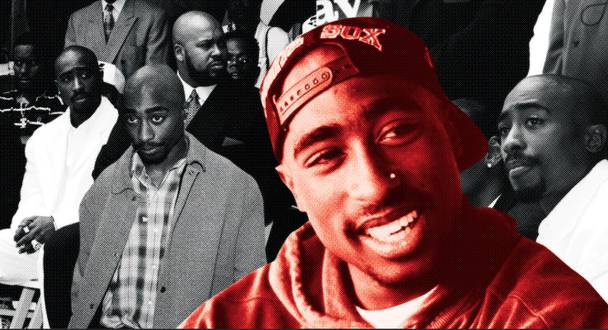
Las Vegas Metropolitan Police are really great at solving murders. In 2020, LVMPD homicide detectives cracked nearly 93% of cases, well above the national average, according to a recent story by Fox 5. But after 25 years, one case remains famously unsolved: the murder of Tupac Shakur.
Why is one of the city’s most famous homicides still a mystery after all these years? And who was guilty? Metro declined to comment on the case for this story, but as all celebrity cold cases, endless theories abound, some more plausible than others.
Retired Metro officer Chris Carroll, who witnessed Shakur’s last words, has been accused of helping the late icon escape to Cuba. “If he offered me millions of dollars to help him get to Cuba, I might have done it,” Carroll says. “But unfortunately for me, it didn’t happen. … I don’t know where they came up with that one. I guess just because it’s a hard country to access, it makes the story more believable.”
Death Row Records co-founder Suge Knight has long been a subject of suspicion. He was driving the car when Shakur was shot and only sustained a relatively minor injury to the head. “Suge Knight was also shot in the head during this thing,” Carroll says. “A lot of people forget that. It penetrated his scalp but not his skull.”
The Mob Museum’s Geoff Schumacher, who was working for the Las Vegas Sun at the time of the shooting, dismisses Knight as a suspect. “Was there some reason why he might be part of a conspiracy? I don’t think there’s a lot to that, but there are people who believe it still to this day,” Schumacher says.
Others think Shakur, a child of the Black Panther movement, was a victim of his political beliefs. “We believe that he was assassinated, with everything that’s come out and what we know about his background and his family and his relationship with the state and with the police,” says Las Vegas-raised activist Tenisha Freedom. “It’s important for us to make that distinction. We don’t think he was just killed randomly. We believe it was targeted; we believe it was purposeful.”
The most agreed-upon solution is that the killer is alleged rival gang member Orlando Anderson, who himself was later shot to death.
“It’s unfortunate that the police have not named the killer when they basically know who it is,” says investigative journalist and true crime author Cathy Scott. She covered the original story of the shooting for the Las Vegas Sun and then went on to write a best-selling book about it, The Killing of Tupac Shakur. “Compton PD basically laid it out for them. Orlando Anderson was running all over the Compton area bragging, ‘I shot Tupac cuz he beat me up.’ Then he stopped doing that after Tupac died.”
Scott says the motive was simply retaliation—a way to even the score a few hours after Shakur and his bodyguards assaulted Anderson at the MGM Grand. “It’s real simple,” Scott says. “There’s nothing complicated about what gangs do: You do this to me, I do this to you.”
As to why the case was never solved, Scott speculates that it was a reaction to the gangland code of silence. “Early on, I think they made a decision [that] nobody’s cooperating, we can’t get enough information,” Scott says.
Another possible reason for the impasse? The desire to avoid any kind of publicity that might associate Las Vegas with crime. “It’s all about tourism,” Scott says. “I think if it happened in another town, it would have been solved pretty early.”
Schumacher says the police might have lacked enough evidence for a conviction. “The fact that the police knew who did it doesn’t mean you have the evidence to hold a trial and convict somebody of different things,” Schumacher says. “The fact that we all think he did it doesn’t really mesh with our system of jurisprudence.”
Essential ’Pac
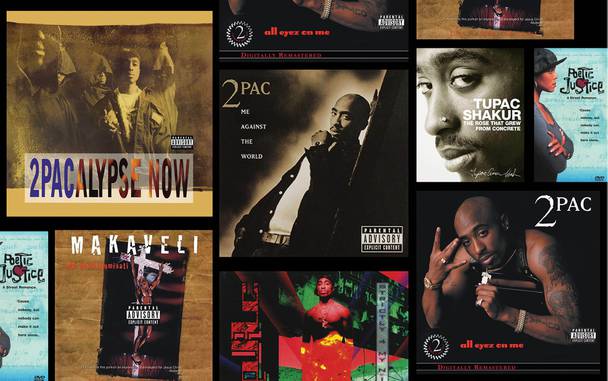
2Pacalypse Now Hip-hop magazine The Source has called Shakur’s 1991 debut his most politically influenced LP, writing, “This was not an album for the radio; it was an album for the people.”
Juice After a cameo in 1991’s Nothing but Trouble, Shakur revealed his acting star power playing the haunting and haunted Roland Bishop in this 1992 film.
Strictly 4 My N.I.G.G.A.Z… Shakur’s 1993 sophomore album “finds him with a lot on his mind. He comes with a sense of drive and eruptive, dissident, dissonant fervor worthy of [Public Enemy’s] Fear of a Black Planet and [Ice Cube’s] AmeriKKKa’s Most Wanted.” (The New Rolling Stone Album Guide)
Poetic Justice Shakur starred opposite Janet Jackson in this 1993 romantic drama from director John Singleton.
All Eyez on Me XXL magazine ranked this 1996 LP, the last released in Shakur’s lifetime, his greatest album—and called it “one of the best rap albums of all time.”
Me Against the World The Guardian called this 1995 album “The most fully formed, relatable iteration of 2Pac” and “an enduring collection of cathartic anthems for anyone who has ever felt oppressed.” Its first single, “Dear Mama,” was added to the Library of Congress’ Recording Registry in 2009.
The Don Killuminati: The 7 Day Theory Complex magazine has called the first of many posthumous Shakur albums—released two months after his death—an “overwhelming, cohesive statement” and “the record that made Pac a god.”
The Rose That Grew from Concrete This 1999 collection of poetry—written by Shakur from 1989 to 1991—reveals yet another side of the artist.
Two local events commemorate the anniversary of Tupac’s death
One Night in Las Vegas: The 25th Anniversary of the Tupac Shakur Murder On September 1, the Mob Museum hosted a special program exploring the legacy of Tupac Shakur, along with as the mystery behind his murder. Panelists included Public Enemy’s Chuck D; the Outlawz’s E.D.I. Mean, who was in the car behind Shakur at the time of his shooting; journalist and film producer Stephanie Frederic; and retired assistant sheriff Greg McCurdy, who worked as Metro’s public information officer at the time. A replay of portions of the event will be made available at themobmuseum.org/events in the coming weeks..
Reading and Signing with Tyler Merritt, author of I Take My Coffee Black: Reflections on Tupac, Musical Theater, Faith and Being Black in America Merritt continues the conversation on culture, race and racism in America that Shakur took part in. You might know him from his viral video, “Before You Call the Cops.” The Vegas-raised actor and comedian returns to town for a reading and discussion of his book. September 18, 7-8 p.m., free. Writer’s Block, 519 S. 6th St., 702-550-6399.
Learn more
Visit the website for the Tupac Amaru Shakur Foundation for the Arts, a charity based in Georgia and founded by mother Afeni Shakur. Tupacshakurfoundation.org
Read Changes: An Oral History of Tupac Shakur by Sheldon Pearce.
Read The Killing of Tupac Shakur by Cathy Scott
Listen to Slow Burn Season 3. This longform Slate podcast investigates the murders of Shakur and The Notorious B.I.G.
